Comprehensive Report on Business Negotiation Strategies at Richemont
VerifiedAdded on 2020/11/23
|12
|4142
|109
Report
AI Summary
This report delves into the negotiation strategies employed by Richemont, a prominent company in the business administration field. It meticulously examines the requirements of a successful negotiation strategy, including the importance of politeness, tactics, and the use of various negotiation techniques such as the Persuasion Tools Model, Win-Win Tool, and Lewicki & Hiam Model. The report emphasizes the significance of researching the other party to understand their objectives and potential strategies, while also exploring the impact of cultural differences on negotiation approaches. Furthermore, it covers the purpose, scope, and objectives of negotiation, the authority required, and the preparation of effective negotiation strategies, including fallback stances and compromises. The report also addresses maintaining accurate records of negotiations and adhering to ethical and legal requirements, offering a comprehensive overview of business negotiation practices within the context of Richemont.
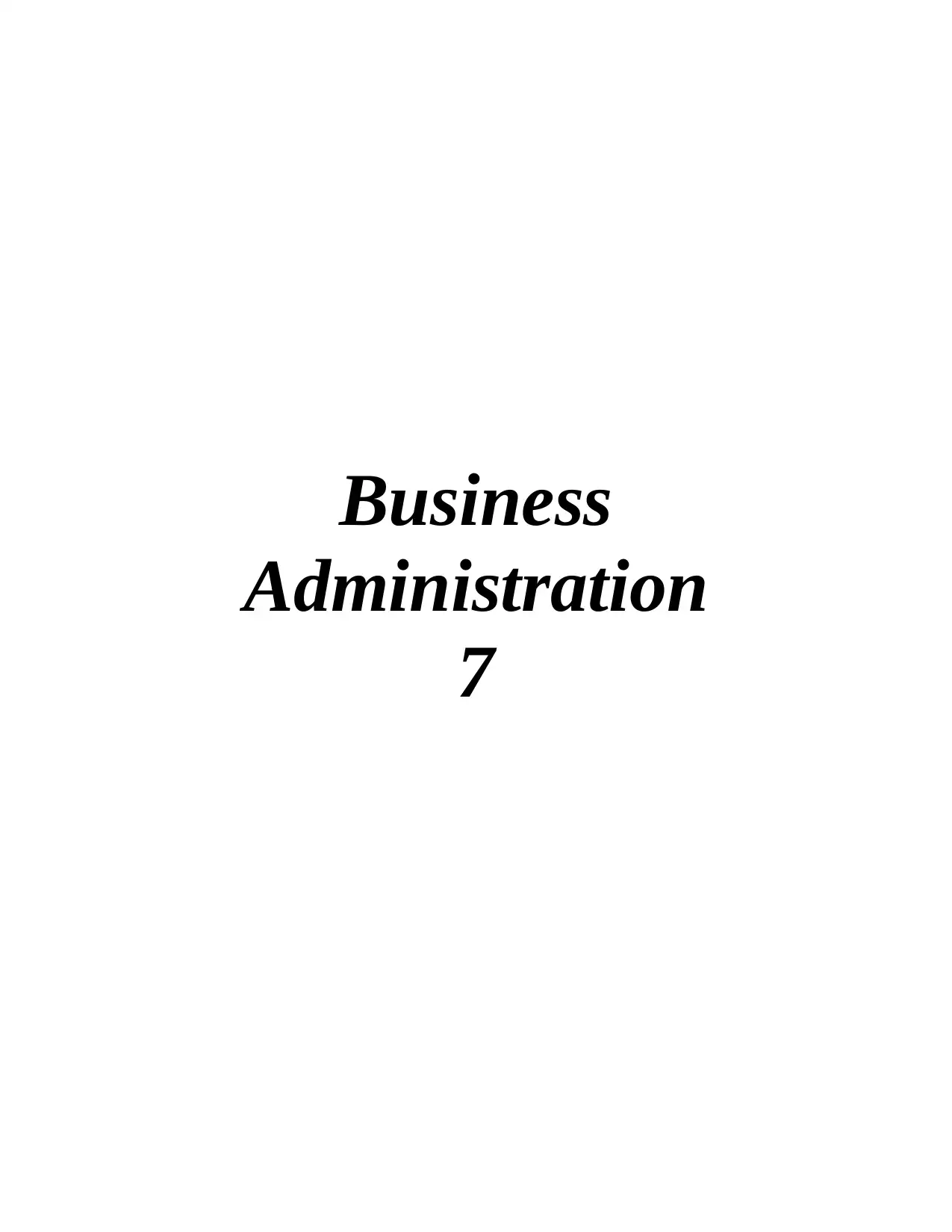
Business
Administration
7
Administration
7
Paraphrase This Document
Need a fresh take? Get an instant paraphrase of this document with our AI Paraphraser
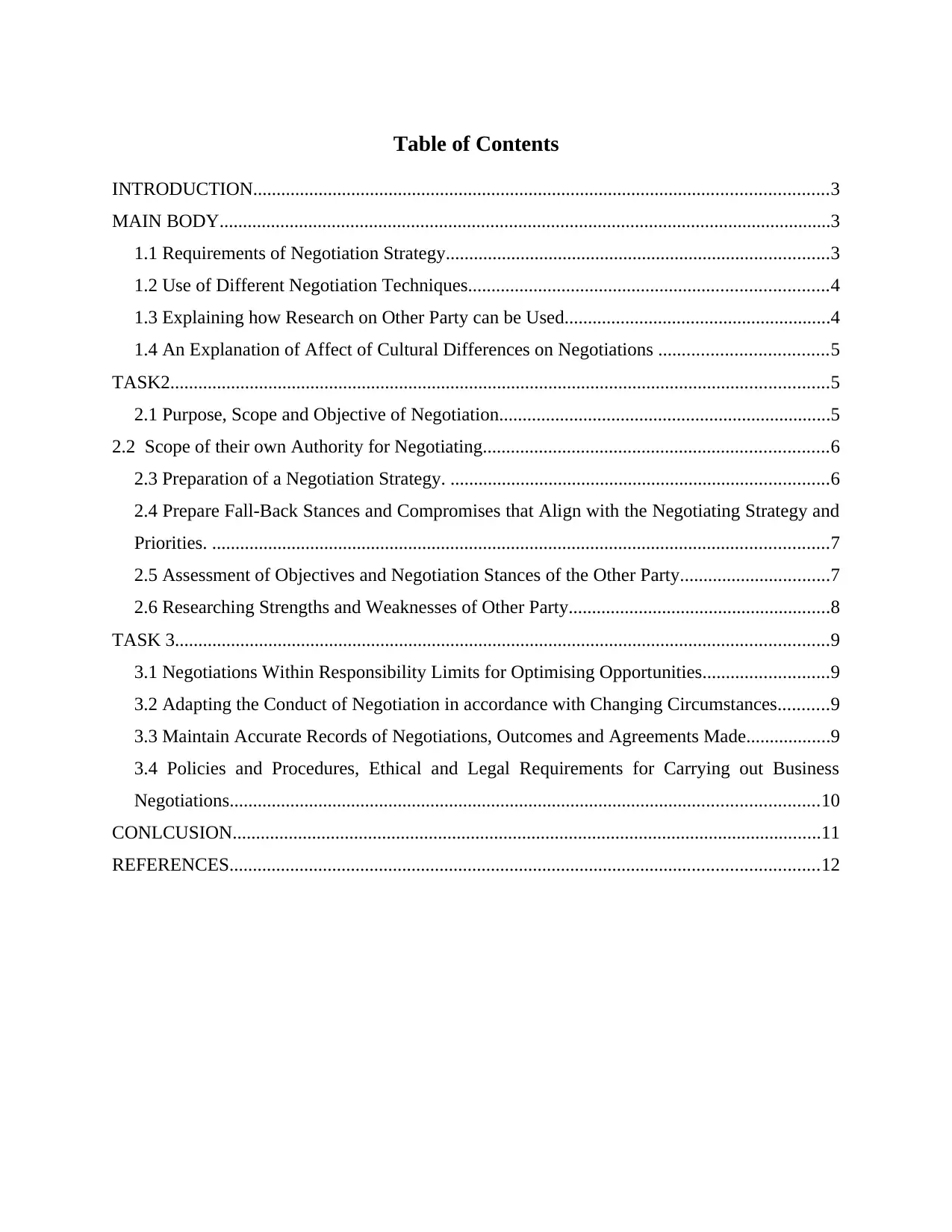
Table of Contents
INTRODUCTION...........................................................................................................................3
MAIN BODY...................................................................................................................................3
1.1 Requirements of Negotiation Strategy..................................................................................3
1.2 Use of Different Negotiation Techniques.............................................................................4
1.3 Explaining how Research on Other Party can be Used.........................................................4
1.4 An Explanation of Affect of Cultural Differences on Negotiations ....................................5
TASK2.............................................................................................................................................5
2.1 Purpose, Scope and Objective of Negotiation.......................................................................5
2.2 Scope of their own Authority for Negotiating..........................................................................6
2.3 Preparation of a Negotiation Strategy. .................................................................................6
2.4 Prepare Fall-Back Stances and Compromises that Align with the Negotiating Strategy and
Priorities. ....................................................................................................................................7
2.5 Assessment of Objectives and Negotiation Stances of the Other Party................................7
2.6 Researching Strengths and Weaknesses of Other Party........................................................8
TASK 3............................................................................................................................................9
3.1 Negotiations Within Responsibility Limits for Optimising Opportunities...........................9
3.2 Adapting the Conduct of Negotiation in accordance with Changing Circumstances...........9
3.3 Maintain Accurate Records of Negotiations, Outcomes and Agreements Made..................9
3.4 Policies and Procedures, Ethical and Legal Requirements for Carrying out Business
Negotiations..............................................................................................................................10
CONLCUSION..............................................................................................................................11
REFERENCES..............................................................................................................................12
INTRODUCTION...........................................................................................................................3
MAIN BODY...................................................................................................................................3
1.1 Requirements of Negotiation Strategy..................................................................................3
1.2 Use of Different Negotiation Techniques.............................................................................4
1.3 Explaining how Research on Other Party can be Used.........................................................4
1.4 An Explanation of Affect of Cultural Differences on Negotiations ....................................5
TASK2.............................................................................................................................................5
2.1 Purpose, Scope and Objective of Negotiation.......................................................................5
2.2 Scope of their own Authority for Negotiating..........................................................................6
2.3 Preparation of a Negotiation Strategy. .................................................................................6
2.4 Prepare Fall-Back Stances and Compromises that Align with the Negotiating Strategy and
Priorities. ....................................................................................................................................7
2.5 Assessment of Objectives and Negotiation Stances of the Other Party................................7
2.6 Researching Strengths and Weaknesses of Other Party........................................................8
TASK 3............................................................................................................................................9
3.1 Negotiations Within Responsibility Limits for Optimising Opportunities...........................9
3.2 Adapting the Conduct of Negotiation in accordance with Changing Circumstances...........9
3.3 Maintain Accurate Records of Negotiations, Outcomes and Agreements Made..................9
3.4 Policies and Procedures, Ethical and Legal Requirements for Carrying out Business
Negotiations..............................................................................................................................10
CONLCUSION..............................................................................................................................11
REFERENCES..............................................................................................................................12
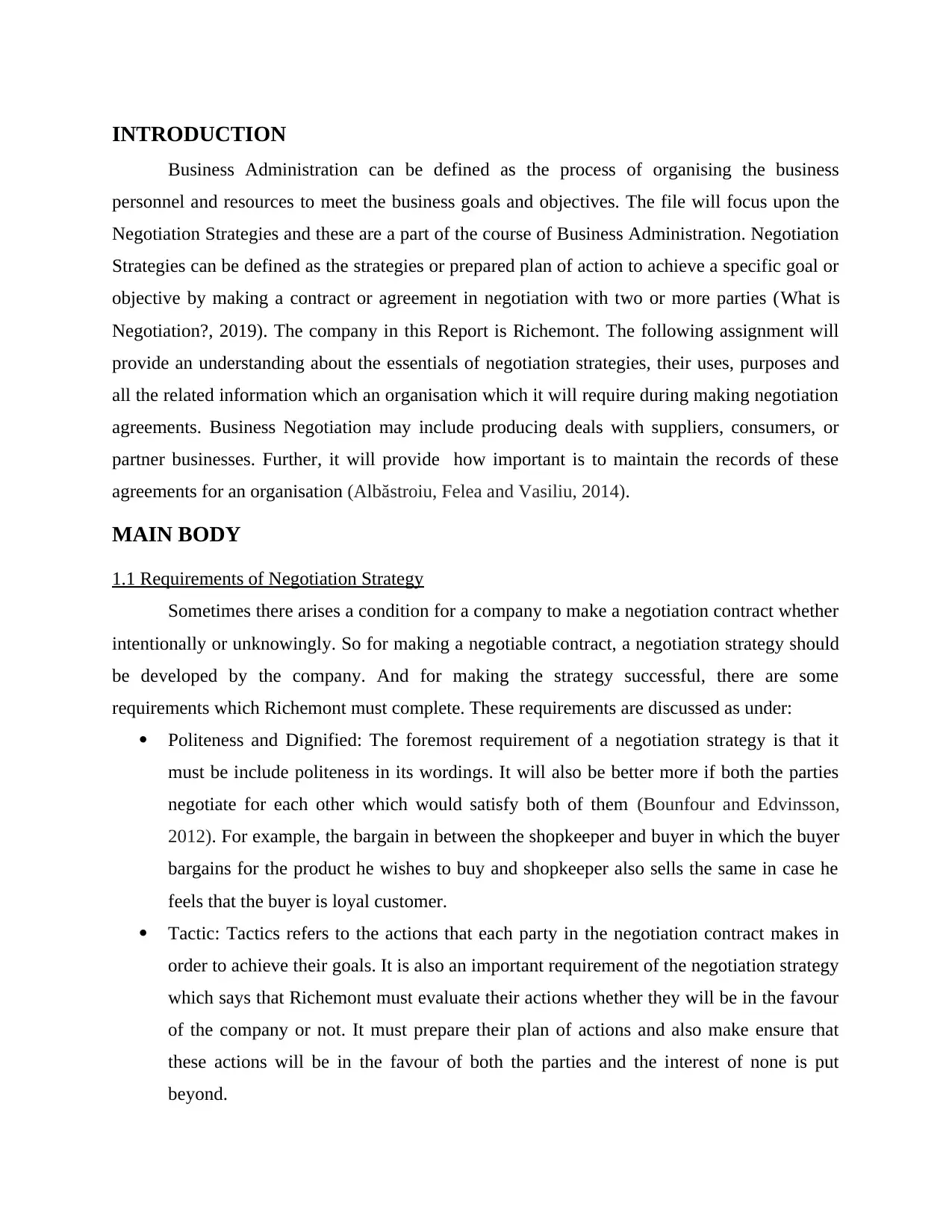
INTRODUCTION
Business Administration can be defined as the process of organising the business
personnel and resources to meet the business goals and objectives. The file will focus upon the
Negotiation Strategies and these are a part of the course of Business Administration. Negotiation
Strategies can be defined as the strategies or prepared plan of action to achieve a specific goal or
objective by making a contract or agreement in negotiation with two or more parties (What is
Negotiation?, 2019). The company in this Report is Richemont. The following assignment will
provide an understanding about the essentials of negotiation strategies, their uses, purposes and
all the related information which an organisation which it will require during making negotiation
agreements. Business Negotiation may include producing deals with suppliers, consumers, or
partner businesses. Further, it will provide how important is to maintain the records of these
agreements for an organisation (Albăstroiu, Felea and Vasiliu, 2014).
MAIN BODY
1.1 Requirements of Negotiation Strategy
Sometimes there arises a condition for a company to make a negotiation contract whether
intentionally or unknowingly. So for making a negotiable contract, a negotiation strategy should
be developed by the company. And for making the strategy successful, there are some
requirements which Richemont must complete. These requirements are discussed as under:
Politeness and Dignified: The foremost requirement of a negotiation strategy is that it
must be include politeness in its wordings. It will also be better more if both the parties
negotiate for each other which would satisfy both of them (Bounfour and Edvinsson,
2012). For example, the bargain in between the shopkeeper and buyer in which the buyer
bargains for the product he wishes to buy and shopkeeper also sells the same in case he
feels that the buyer is loyal customer.
Tactic: Tactics refers to the actions that each party in the negotiation contract makes in
order to achieve their goals. It is also an important requirement of the negotiation strategy
which says that Richemont must evaluate their actions whether they will be in the favour
of the company or not. It must prepare their plan of actions and also make ensure that
these actions will be in the favour of both the parties and the interest of none is put
beyond.
Business Administration can be defined as the process of organising the business
personnel and resources to meet the business goals and objectives. The file will focus upon the
Negotiation Strategies and these are a part of the course of Business Administration. Negotiation
Strategies can be defined as the strategies or prepared plan of action to achieve a specific goal or
objective by making a contract or agreement in negotiation with two or more parties (What is
Negotiation?, 2019). The company in this Report is Richemont. The following assignment will
provide an understanding about the essentials of negotiation strategies, their uses, purposes and
all the related information which an organisation which it will require during making negotiation
agreements. Business Negotiation may include producing deals with suppliers, consumers, or
partner businesses. Further, it will provide how important is to maintain the records of these
agreements for an organisation (Albăstroiu, Felea and Vasiliu, 2014).
MAIN BODY
1.1 Requirements of Negotiation Strategy
Sometimes there arises a condition for a company to make a negotiation contract whether
intentionally or unknowingly. So for making a negotiable contract, a negotiation strategy should
be developed by the company. And for making the strategy successful, there are some
requirements which Richemont must complete. These requirements are discussed as under:
Politeness and Dignified: The foremost requirement of a negotiation strategy is that it
must be include politeness in its wordings. It will also be better more if both the parties
negotiate for each other which would satisfy both of them (Bounfour and Edvinsson,
2012). For example, the bargain in between the shopkeeper and buyer in which the buyer
bargains for the product he wishes to buy and shopkeeper also sells the same in case he
feels that the buyer is loyal customer.
Tactic: Tactics refers to the actions that each party in the negotiation contract makes in
order to achieve their goals. It is also an important requirement of the negotiation strategy
which says that Richemont must evaluate their actions whether they will be in the favour
of the company or not. It must prepare their plan of actions and also make ensure that
these actions will be in the favour of both the parties and the interest of none is put
beyond.
⊘ This is a preview!⊘
Do you want full access?
Subscribe today to unlock all pages.

Trusted by 1+ million students worldwide
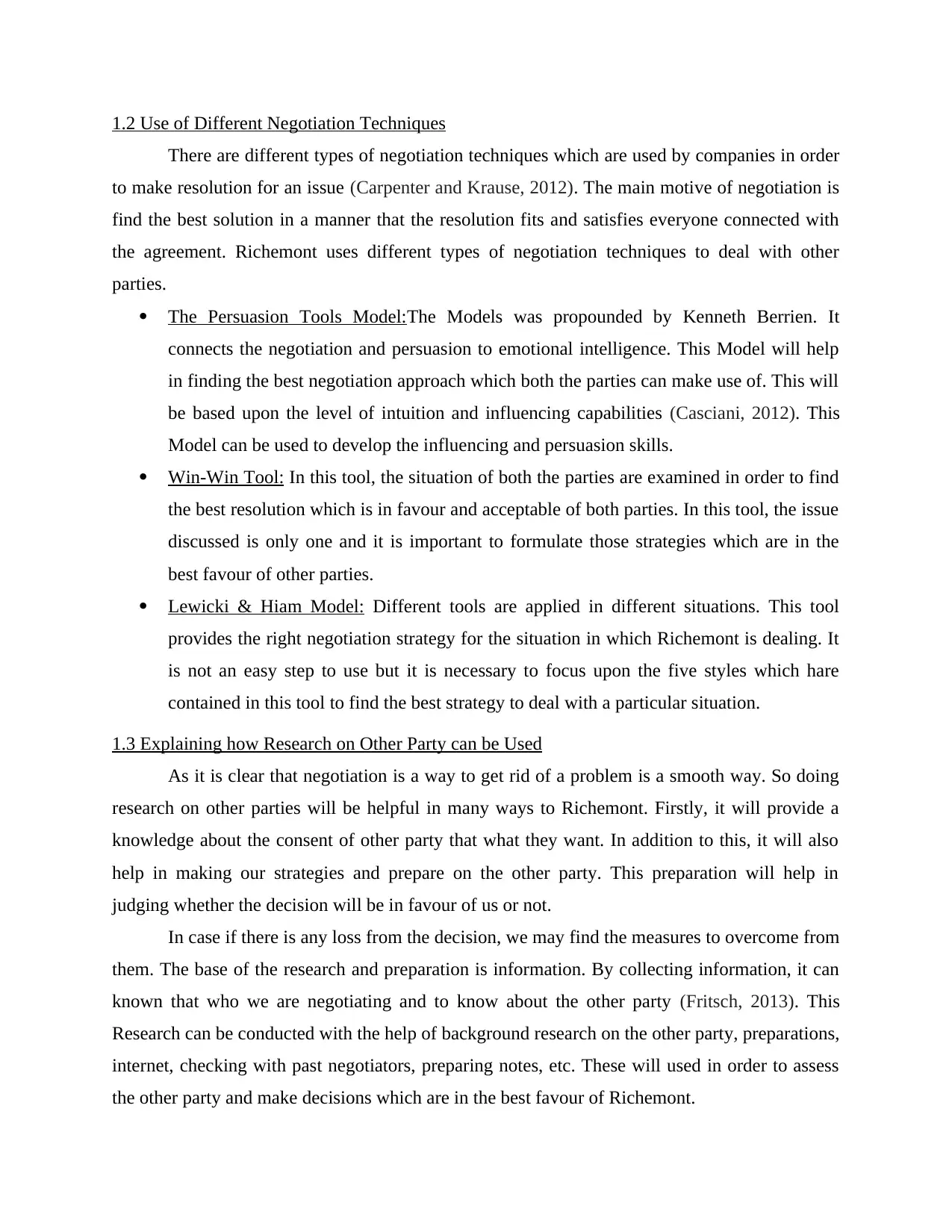
1.2 Use of Different Negotiation Techniques
There are different types of negotiation techniques which are used by companies in order
to make resolution for an issue (Carpenter and Krause, 2012). The main motive of negotiation is
find the best solution in a manner that the resolution fits and satisfies everyone connected with
the agreement. Richemont uses different types of negotiation techniques to deal with other
parties.
The Persuasion Tools Model:The Models was propounded by Kenneth Berrien. It
connects the negotiation and persuasion to emotional intelligence. This Model will help
in finding the best negotiation approach which both the parties can make use of. This will
be based upon the level of intuition and influencing capabilities (Casciani, 2012). This
Model can be used to develop the influencing and persuasion skills.
Win-Win Tool: In this tool, the situation of both the parties are examined in order to find
the best resolution which is in favour and acceptable of both parties. In this tool, the issue
discussed is only one and it is important to formulate those strategies which are in the
best favour of other parties.
Lewicki & Hiam Model: Different tools are applied in different situations. This tool
provides the right negotiation strategy for the situation in which Richemont is dealing. It
is not an easy step to use but it is necessary to focus upon the five styles which hare
contained in this tool to find the best strategy to deal with a particular situation.
1.3 Explaining how Research on Other Party can be Used
As it is clear that negotiation is a way to get rid of a problem is a smooth way. So doing
research on other parties will be helpful in many ways to Richemont. Firstly, it will provide a
knowledge about the consent of other party that what they want. In addition to this, it will also
help in making our strategies and prepare on the other party. This preparation will help in
judging whether the decision will be in favour of us or not.
In case if there is any loss from the decision, we may find the measures to overcome from
them. The base of the research and preparation is information. By collecting information, it can
known that who we are negotiating and to know about the other party (Fritsch, 2013). This
Research can be conducted with the help of background research on the other party, preparations,
internet, checking with past negotiators, preparing notes, etc. These will used in order to assess
the other party and make decisions which are in the best favour of Richemont.
There are different types of negotiation techniques which are used by companies in order
to make resolution for an issue (Carpenter and Krause, 2012). The main motive of negotiation is
find the best solution in a manner that the resolution fits and satisfies everyone connected with
the agreement. Richemont uses different types of negotiation techniques to deal with other
parties.
The Persuasion Tools Model:The Models was propounded by Kenneth Berrien. It
connects the negotiation and persuasion to emotional intelligence. This Model will help
in finding the best negotiation approach which both the parties can make use of. This will
be based upon the level of intuition and influencing capabilities (Casciani, 2012). This
Model can be used to develop the influencing and persuasion skills.
Win-Win Tool: In this tool, the situation of both the parties are examined in order to find
the best resolution which is in favour and acceptable of both parties. In this tool, the issue
discussed is only one and it is important to formulate those strategies which are in the
best favour of other parties.
Lewicki & Hiam Model: Different tools are applied in different situations. This tool
provides the right negotiation strategy for the situation in which Richemont is dealing. It
is not an easy step to use but it is necessary to focus upon the five styles which hare
contained in this tool to find the best strategy to deal with a particular situation.
1.3 Explaining how Research on Other Party can be Used
As it is clear that negotiation is a way to get rid of a problem is a smooth way. So doing
research on other parties will be helpful in many ways to Richemont. Firstly, it will provide a
knowledge about the consent of other party that what they want. In addition to this, it will also
help in making our strategies and prepare on the other party. This preparation will help in
judging whether the decision will be in favour of us or not.
In case if there is any loss from the decision, we may find the measures to overcome from
them. The base of the research and preparation is information. By collecting information, it can
known that who we are negotiating and to know about the other party (Fritsch, 2013). This
Research can be conducted with the help of background research on the other party, preparations,
internet, checking with past negotiators, preparing notes, etc. These will used in order to assess
the other party and make decisions which are in the best favour of Richemont.
Paraphrase This Document
Need a fresh take? Get an instant paraphrase of this document with our AI Paraphraser
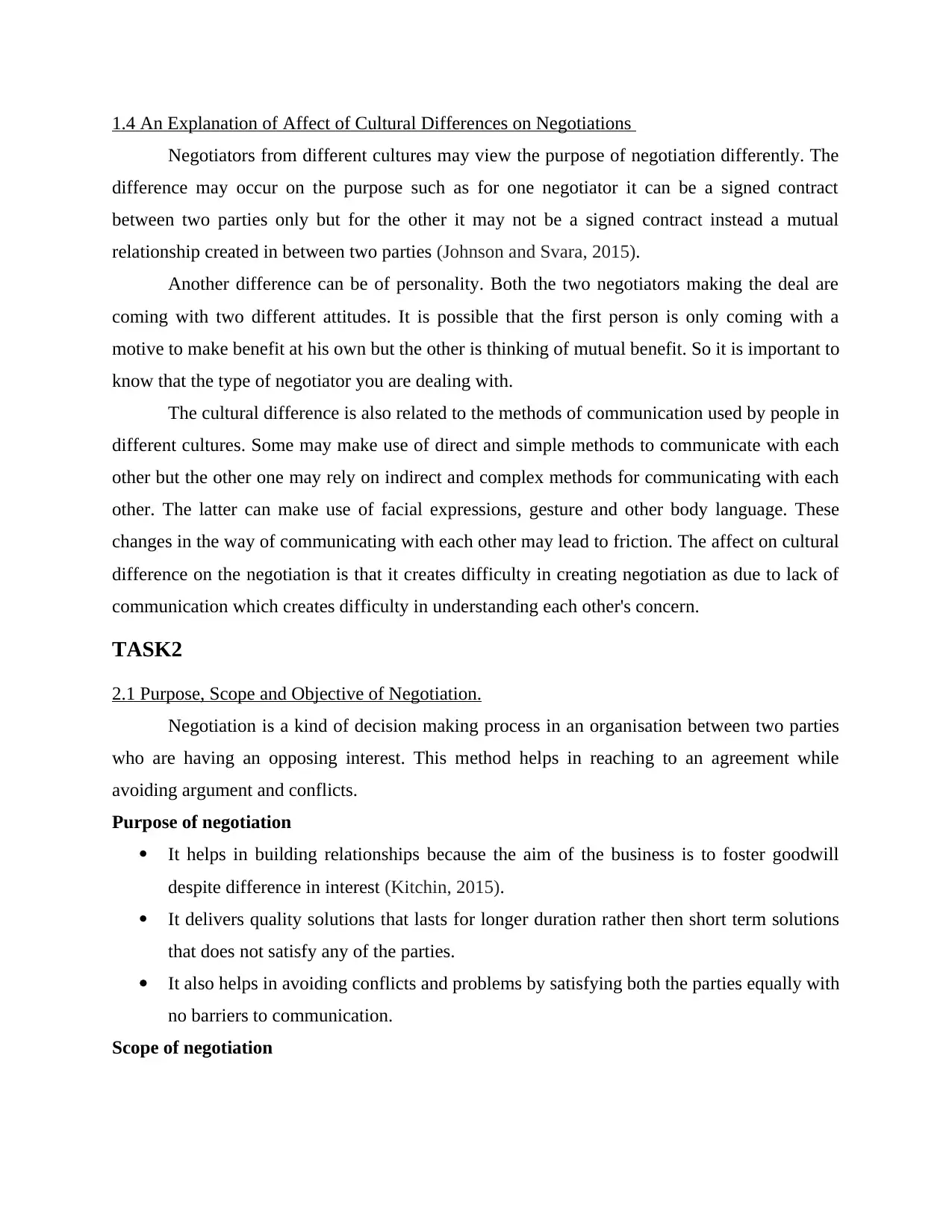
1.4 An Explanation of Affect of Cultural Differences on Negotiations
Negotiators from different cultures may view the purpose of negotiation differently. The
difference may occur on the purpose such as for one negotiator it can be a signed contract
between two parties only but for the other it may not be a signed contract instead a mutual
relationship created in between two parties (Johnson and Svara, 2015).
Another difference can be of personality. Both the two negotiators making the deal are
coming with two different attitudes. It is possible that the first person is only coming with a
motive to make benefit at his own but the other is thinking of mutual benefit. So it is important to
know that the type of negotiator you are dealing with.
The cultural difference is also related to the methods of communication used by people in
different cultures. Some may make use of direct and simple methods to communicate with each
other but the other one may rely on indirect and complex methods for communicating with each
other. The latter can make use of facial expressions, gesture and other body language. These
changes in the way of communicating with each other may lead to friction. The affect on cultural
difference on the negotiation is that it creates difficulty in creating negotiation as due to lack of
communication which creates difficulty in understanding each other's concern.
TASK2
2.1 Purpose, Scope and Objective of Negotiation.
Negotiation is a kind of decision making process in an organisation between two parties
who are having an opposing interest. This method helps in reaching to an agreement while
avoiding argument and conflicts.
Purpose of negotiation
It helps in building relationships because the aim of the business is to foster goodwill
despite difference in interest (Kitchin, 2015).
It delivers quality solutions that lasts for longer duration rather then short term solutions
that does not satisfy any of the parties.
It also helps in avoiding conflicts and problems by satisfying both the parties equally with
no barriers to communication.
Scope of negotiation
Negotiators from different cultures may view the purpose of negotiation differently. The
difference may occur on the purpose such as for one negotiator it can be a signed contract
between two parties only but for the other it may not be a signed contract instead a mutual
relationship created in between two parties (Johnson and Svara, 2015).
Another difference can be of personality. Both the two negotiators making the deal are
coming with two different attitudes. It is possible that the first person is only coming with a
motive to make benefit at his own but the other is thinking of mutual benefit. So it is important to
know that the type of negotiator you are dealing with.
The cultural difference is also related to the methods of communication used by people in
different cultures. Some may make use of direct and simple methods to communicate with each
other but the other one may rely on indirect and complex methods for communicating with each
other. The latter can make use of facial expressions, gesture and other body language. These
changes in the way of communicating with each other may lead to friction. The affect on cultural
difference on the negotiation is that it creates difficulty in creating negotiation as due to lack of
communication which creates difficulty in understanding each other's concern.
TASK2
2.1 Purpose, Scope and Objective of Negotiation.
Negotiation is a kind of decision making process in an organisation between two parties
who are having an opposing interest. This method helps in reaching to an agreement while
avoiding argument and conflicts.
Purpose of negotiation
It helps in building relationships because the aim of the business is to foster goodwill
despite difference in interest (Kitchin, 2015).
It delivers quality solutions that lasts for longer duration rather then short term solutions
that does not satisfy any of the parties.
It also helps in avoiding conflicts and problems by satisfying both the parties equally with
no barriers to communication.
Scope of negotiation
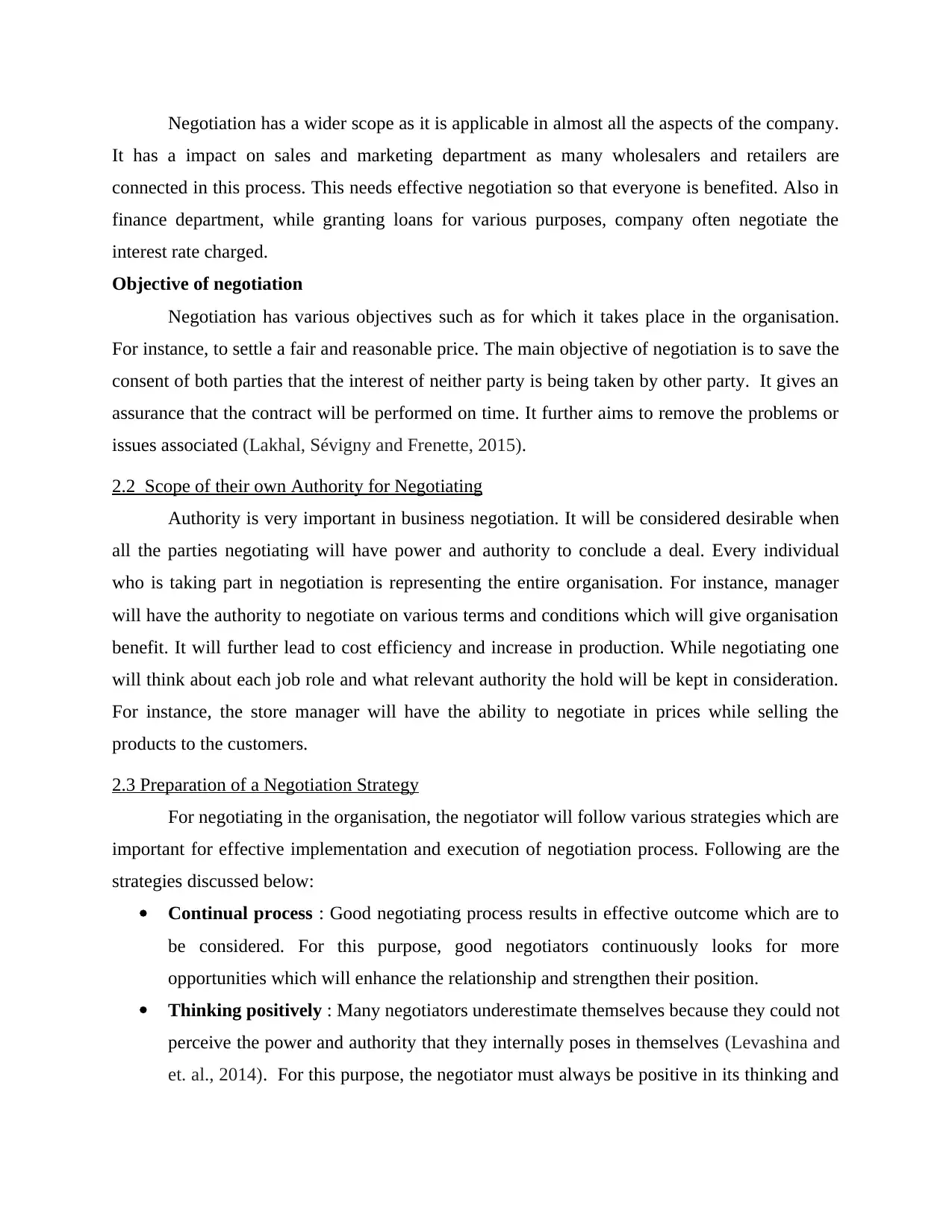
Negotiation has a wider scope as it is applicable in almost all the aspects of the company.
It has a impact on sales and marketing department as many wholesalers and retailers are
connected in this process. This needs effective negotiation so that everyone is benefited. Also in
finance department, while granting loans for various purposes, company often negotiate the
interest rate charged.
Objective of negotiation
Negotiation has various objectives such as for which it takes place in the organisation.
For instance, to settle a fair and reasonable price. The main objective of negotiation is to save the
consent of both parties that the interest of neither party is being taken by other party. It gives an
assurance that the contract will be performed on time. It further aims to remove the problems or
issues associated (Lakhal, Sévigny and Frenette, 2015).
2.2 Scope of their own Authority for Negotiating
Authority is very important in business negotiation. It will be considered desirable when
all the parties negotiating will have power and authority to conclude a deal. Every individual
who is taking part in negotiation is representing the entire organisation. For instance, manager
will have the authority to negotiate on various terms and conditions which will give organisation
benefit. It will further lead to cost efficiency and increase in production. While negotiating one
will think about each job role and what relevant authority the hold will be kept in consideration.
For instance, the store manager will have the ability to negotiate in prices while selling the
products to the customers.
2.3 Preparation of a Negotiation Strategy
For negotiating in the organisation, the negotiator will follow various strategies which are
important for effective implementation and execution of negotiation process. Following are the
strategies discussed below:
Continual process : Good negotiating process results in effective outcome which are to
be considered. For this purpose, good negotiators continuously looks for more
opportunities which will enhance the relationship and strengthen their position.
Thinking positively : Many negotiators underestimate themselves because they could not
perceive the power and authority that they internally poses in themselves (Levashina and
et. al., 2014). For this purpose, the negotiator must always be positive in its thinking and
It has a impact on sales and marketing department as many wholesalers and retailers are
connected in this process. This needs effective negotiation so that everyone is benefited. Also in
finance department, while granting loans for various purposes, company often negotiate the
interest rate charged.
Objective of negotiation
Negotiation has various objectives such as for which it takes place in the organisation.
For instance, to settle a fair and reasonable price. The main objective of negotiation is to save the
consent of both parties that the interest of neither party is being taken by other party. It gives an
assurance that the contract will be performed on time. It further aims to remove the problems or
issues associated (Lakhal, Sévigny and Frenette, 2015).
2.2 Scope of their own Authority for Negotiating
Authority is very important in business negotiation. It will be considered desirable when
all the parties negotiating will have power and authority to conclude a deal. Every individual
who is taking part in negotiation is representing the entire organisation. For instance, manager
will have the authority to negotiate on various terms and conditions which will give organisation
benefit. It will further lead to cost efficiency and increase in production. While negotiating one
will think about each job role and what relevant authority the hold will be kept in consideration.
For instance, the store manager will have the ability to negotiate in prices while selling the
products to the customers.
2.3 Preparation of a Negotiation Strategy
For negotiating in the organisation, the negotiator will follow various strategies which are
important for effective implementation and execution of negotiation process. Following are the
strategies discussed below:
Continual process : Good negotiating process results in effective outcome which are to
be considered. For this purpose, good negotiators continuously looks for more
opportunities which will enhance the relationship and strengthen their position.
Thinking positively : Many negotiators underestimate themselves because they could not
perceive the power and authority that they internally poses in themselves (Levashina and
et. al., 2014). For this purpose, the negotiator must always be positive in its thinking and
⊘ This is a preview!⊘
Do you want full access?
Subscribe today to unlock all pages.

Trusted by 1+ million students worldwide
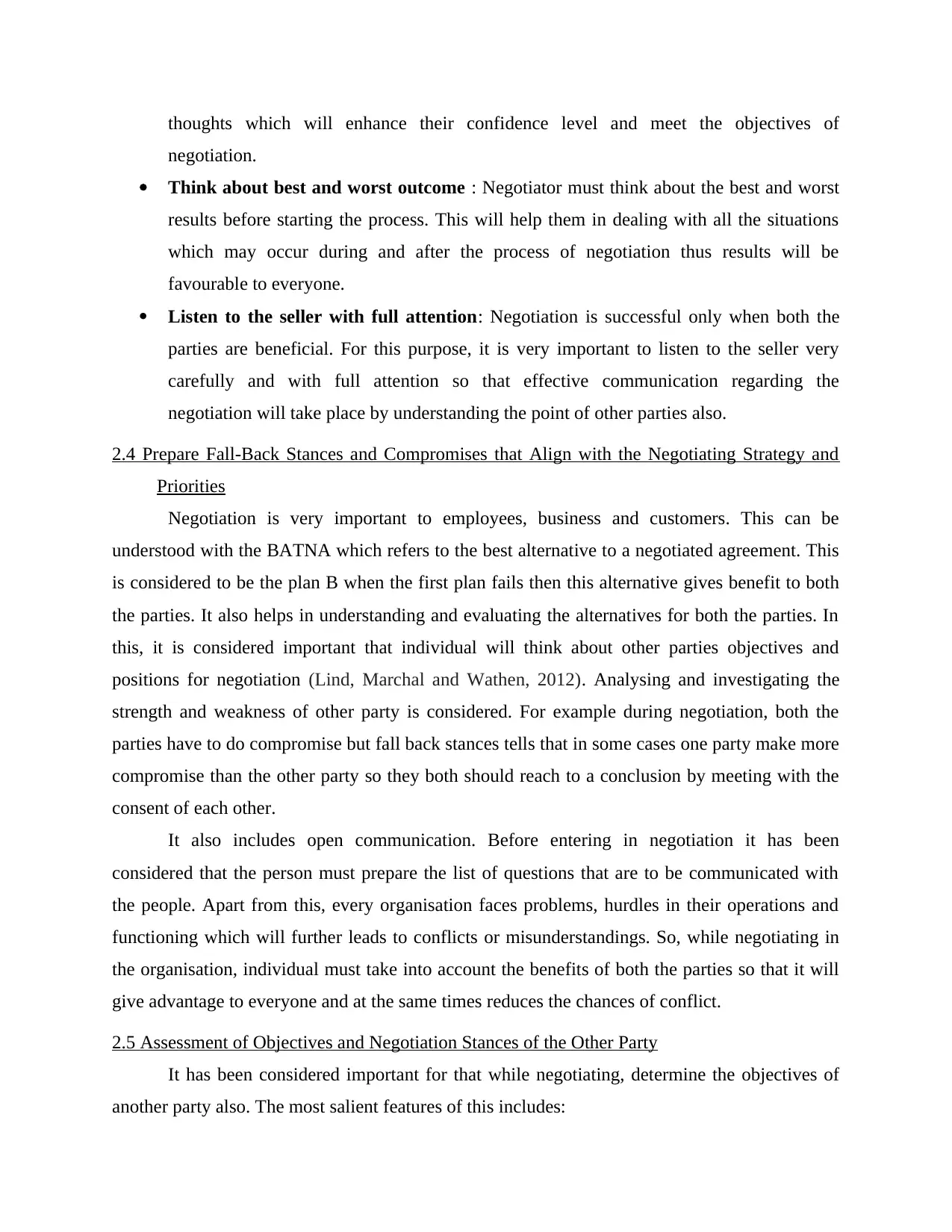
thoughts which will enhance their confidence level and meet the objectives of
negotiation.
Think about best and worst outcome : Negotiator must think about the best and worst
results before starting the process. This will help them in dealing with all the situations
which may occur during and after the process of negotiation thus results will be
favourable to everyone.
Listen to the seller with full attention: Negotiation is successful only when both the
parties are beneficial. For this purpose, it is very important to listen to the seller very
carefully and with full attention so that effective communication regarding the
negotiation will take place by understanding the point of other parties also.
2.4 Prepare Fall-Back Stances and Compromises that Align with the Negotiating Strategy and
Priorities
Negotiation is very important to employees, business and customers. This can be
understood with the BATNA which refers to the best alternative to a negotiated agreement. This
is considered to be the plan B when the first plan fails then this alternative gives benefit to both
the parties. It also helps in understanding and evaluating the alternatives for both the parties. In
this, it is considered important that individual will think about other parties objectives and
positions for negotiation (Lind, Marchal and Wathen, 2012). Analysing and investigating the
strength and weakness of other party is considered. For example during negotiation, both the
parties have to do compromise but fall back stances tells that in some cases one party make more
compromise than the other party so they both should reach to a conclusion by meeting with the
consent of each other.
It also includes open communication. Before entering in negotiation it has been
considered that the person must prepare the list of questions that are to be communicated with
the people. Apart from this, every organisation faces problems, hurdles in their operations and
functioning which will further leads to conflicts or misunderstandings. So, while negotiating in
the organisation, individual must take into account the benefits of both the parties so that it will
give advantage to everyone and at the same times reduces the chances of conflict.
2.5 Assessment of Objectives and Negotiation Stances of the Other Party
It has been considered important for that while negotiating, determine the objectives of
another party also. The most salient features of this includes:
negotiation.
Think about best and worst outcome : Negotiator must think about the best and worst
results before starting the process. This will help them in dealing with all the situations
which may occur during and after the process of negotiation thus results will be
favourable to everyone.
Listen to the seller with full attention: Negotiation is successful only when both the
parties are beneficial. For this purpose, it is very important to listen to the seller very
carefully and with full attention so that effective communication regarding the
negotiation will take place by understanding the point of other parties also.
2.4 Prepare Fall-Back Stances and Compromises that Align with the Negotiating Strategy and
Priorities
Negotiation is very important to employees, business and customers. This can be
understood with the BATNA which refers to the best alternative to a negotiated agreement. This
is considered to be the plan B when the first plan fails then this alternative gives benefit to both
the parties. It also helps in understanding and evaluating the alternatives for both the parties. In
this, it is considered important that individual will think about other parties objectives and
positions for negotiation (Lind, Marchal and Wathen, 2012). Analysing and investigating the
strength and weakness of other party is considered. For example during negotiation, both the
parties have to do compromise but fall back stances tells that in some cases one party make more
compromise than the other party so they both should reach to a conclusion by meeting with the
consent of each other.
It also includes open communication. Before entering in negotiation it has been
considered that the person must prepare the list of questions that are to be communicated with
the people. Apart from this, every organisation faces problems, hurdles in their operations and
functioning which will further leads to conflicts or misunderstandings. So, while negotiating in
the organisation, individual must take into account the benefits of both the parties so that it will
give advantage to everyone and at the same times reduces the chances of conflict.
2.5 Assessment of Objectives and Negotiation Stances of the Other Party
It has been considered important for that while negotiating, determine the objectives of
another party also. The most salient features of this includes:
Paraphrase This Document
Need a fresh take? Get an instant paraphrase of this document with our AI Paraphraser
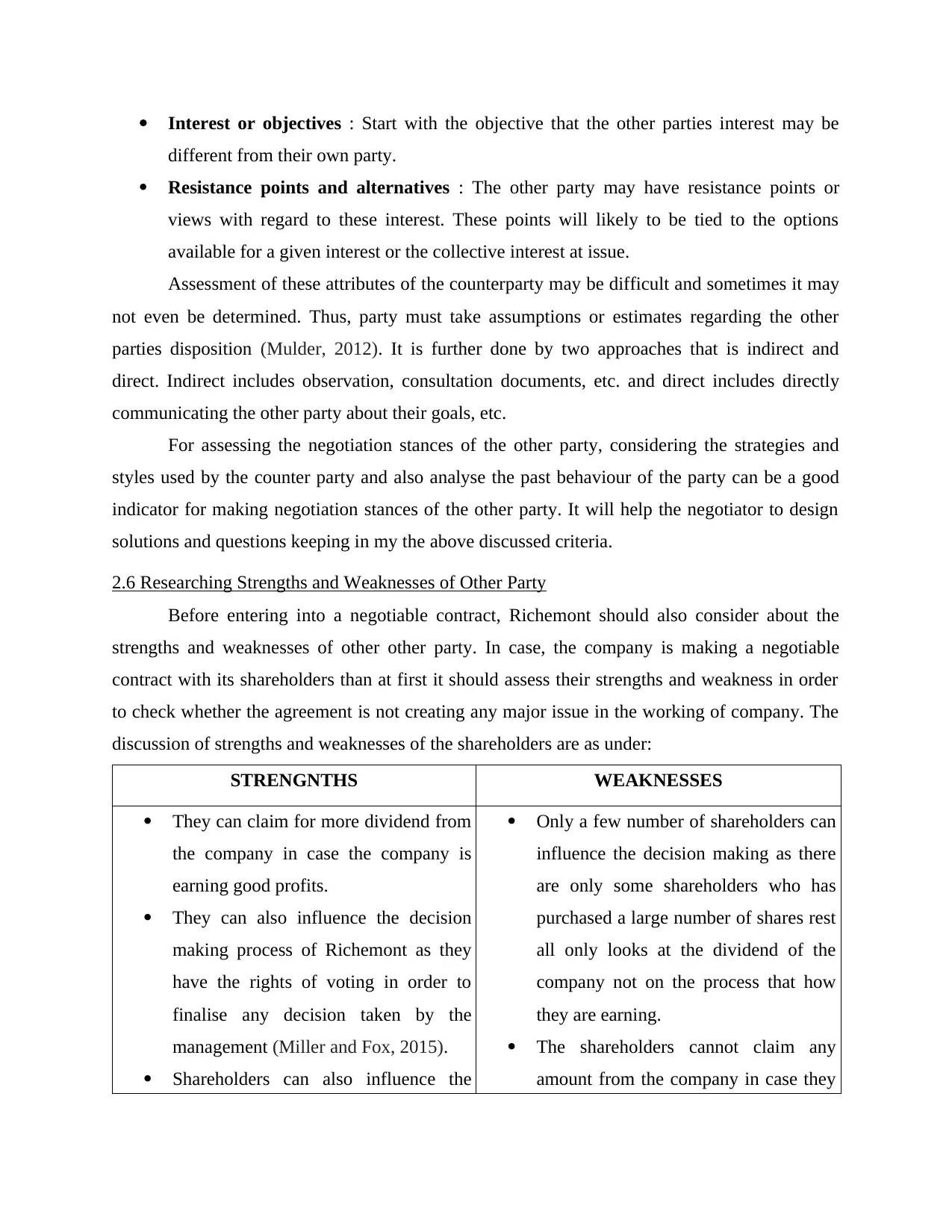
Interest or objectives : Start with the objective that the other parties interest may be
different from their own party.
Resistance points and alternatives : The other party may have resistance points or
views with regard to these interest. These points will likely to be tied to the options
available for a given interest or the collective interest at issue.
Assessment of these attributes of the counterparty may be difficult and sometimes it may
not even be determined. Thus, party must take assumptions or estimates regarding the other
parties disposition (Mulder, 2012). It is further done by two approaches that is indirect and
direct. Indirect includes observation, consultation documents, etc. and direct includes directly
communicating the other party about their goals, etc.
For assessing the negotiation stances of the other party, considering the strategies and
styles used by the counter party and also analyse the past behaviour of the party can be a good
indicator for making negotiation stances of the other party. It will help the negotiator to design
solutions and questions keeping in my the above discussed criteria.
2.6 Researching Strengths and Weaknesses of Other Party
Before entering into a negotiable contract, Richemont should also consider about the
strengths and weaknesses of other other party. In case, the company is making a negotiable
contract with its shareholders than at first it should assess their strengths and weakness in order
to check whether the agreement is not creating any major issue in the working of company. The
discussion of strengths and weaknesses of the shareholders are as under:
STRENGNTHS WEAKNESSES
They can claim for more dividend from
the company in case the company is
earning good profits.
They can also influence the decision
making process of Richemont as they
have the rights of voting in order to
finalise any decision taken by the
management (Miller and Fox, 2015).
Shareholders can also influence the
Only a few number of shareholders can
influence the decision making as there
are only some shareholders who has
purchased a large number of shares rest
all only looks at the dividend of the
company not on the process that how
they are earning.
The shareholders cannot claim any
amount from the company in case they
different from their own party.
Resistance points and alternatives : The other party may have resistance points or
views with regard to these interest. These points will likely to be tied to the options
available for a given interest or the collective interest at issue.
Assessment of these attributes of the counterparty may be difficult and sometimes it may
not even be determined. Thus, party must take assumptions or estimates regarding the other
parties disposition (Mulder, 2012). It is further done by two approaches that is indirect and
direct. Indirect includes observation, consultation documents, etc. and direct includes directly
communicating the other party about their goals, etc.
For assessing the negotiation stances of the other party, considering the strategies and
styles used by the counter party and also analyse the past behaviour of the party can be a good
indicator for making negotiation stances of the other party. It will help the negotiator to design
solutions and questions keeping in my the above discussed criteria.
2.6 Researching Strengths and Weaknesses of Other Party
Before entering into a negotiable contract, Richemont should also consider about the
strengths and weaknesses of other other party. In case, the company is making a negotiable
contract with its shareholders than at first it should assess their strengths and weakness in order
to check whether the agreement is not creating any major issue in the working of company. The
discussion of strengths and weaknesses of the shareholders are as under:
STRENGNTHS WEAKNESSES
They can claim for more dividend from
the company in case the company is
earning good profits.
They can also influence the decision
making process of Richemont as they
have the rights of voting in order to
finalise any decision taken by the
management (Miller and Fox, 2015).
Shareholders can also influence the
Only a few number of shareholders can
influence the decision making as there
are only some shareholders who has
purchased a large number of shares rest
all only looks at the dividend of the
company not on the process that how
they are earning.
The shareholders cannot claim any
amount from the company in case they
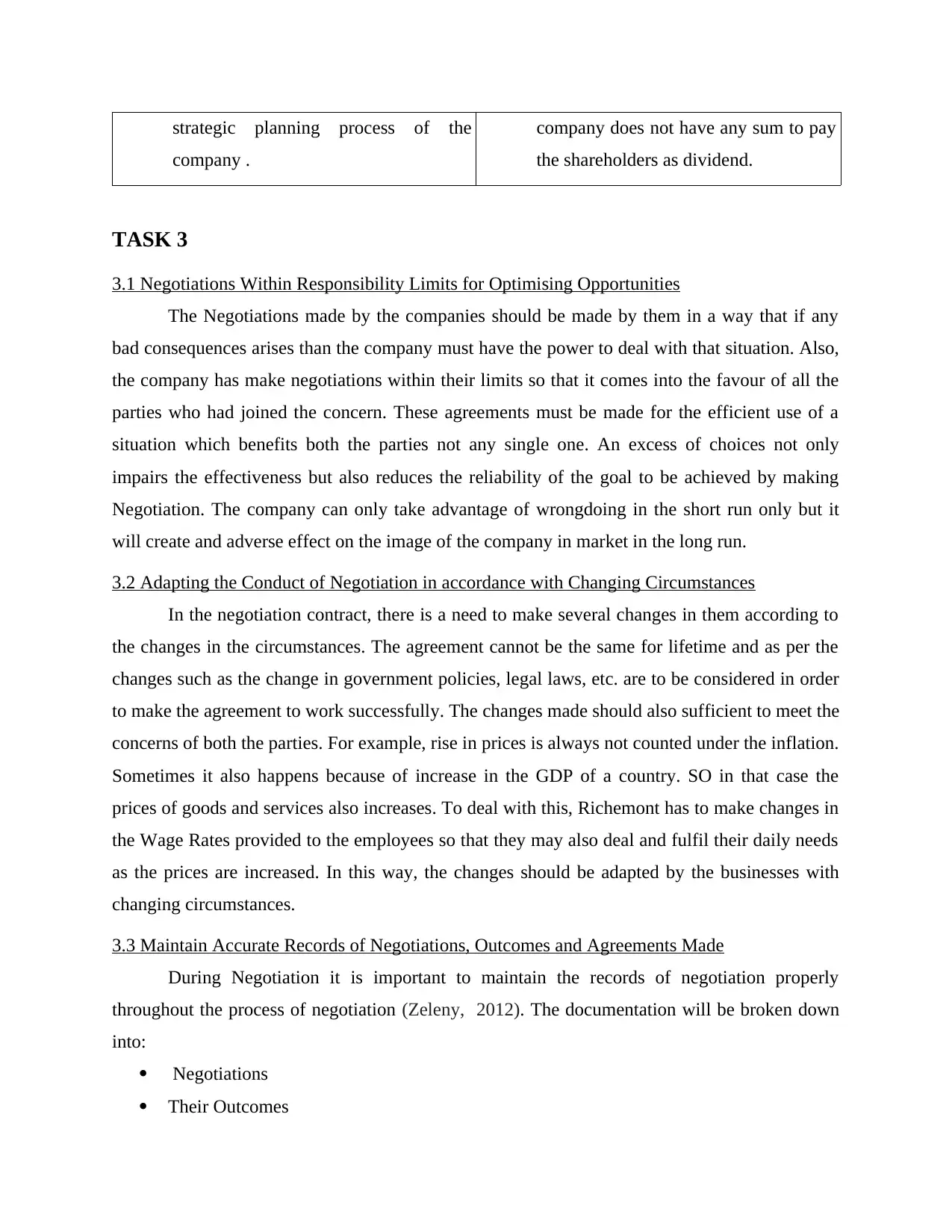
strategic planning process of the
company .
company does not have any sum to pay
the shareholders as dividend.
TASK 3
3.1 Negotiations Within Responsibility Limits for Optimising Opportunities
The Negotiations made by the companies should be made by them in a way that if any
bad consequences arises than the company must have the power to deal with that situation. Also,
the company has make negotiations within their limits so that it comes into the favour of all the
parties who had joined the concern. These agreements must be made for the efficient use of a
situation which benefits both the parties not any single one. An excess of choices not only
impairs the effectiveness but also reduces the reliability of the goal to be achieved by making
Negotiation. The company can only take advantage of wrongdoing in the short run only but it
will create and adverse effect on the image of the company in market in the long run.
3.2 Adapting the Conduct of Negotiation in accordance with Changing Circumstances
In the negotiation contract, there is a need to make several changes in them according to
the changes in the circumstances. The agreement cannot be the same for lifetime and as per the
changes such as the change in government policies, legal laws, etc. are to be considered in order
to make the agreement to work successfully. The changes made should also sufficient to meet the
concerns of both the parties. For example, rise in prices is always not counted under the inflation.
Sometimes it also happens because of increase in the GDP of a country. SO in that case the
prices of goods and services also increases. To deal with this, Richemont has to make changes in
the Wage Rates provided to the employees so that they may also deal and fulfil their daily needs
as the prices are increased. In this way, the changes should be adapted by the businesses with
changing circumstances.
3.3 Maintain Accurate Records of Negotiations, Outcomes and Agreements Made
During Negotiation it is important to maintain the records of negotiation properly
throughout the process of negotiation (Zeleny, 2012). The documentation will be broken down
into:
Negotiations
Their Outcomes
company .
company does not have any sum to pay
the shareholders as dividend.
TASK 3
3.1 Negotiations Within Responsibility Limits for Optimising Opportunities
The Negotiations made by the companies should be made by them in a way that if any
bad consequences arises than the company must have the power to deal with that situation. Also,
the company has make negotiations within their limits so that it comes into the favour of all the
parties who had joined the concern. These agreements must be made for the efficient use of a
situation which benefits both the parties not any single one. An excess of choices not only
impairs the effectiveness but also reduces the reliability of the goal to be achieved by making
Negotiation. The company can only take advantage of wrongdoing in the short run only but it
will create and adverse effect on the image of the company in market in the long run.
3.2 Adapting the Conduct of Negotiation in accordance with Changing Circumstances
In the negotiation contract, there is a need to make several changes in them according to
the changes in the circumstances. The agreement cannot be the same for lifetime and as per the
changes such as the change in government policies, legal laws, etc. are to be considered in order
to make the agreement to work successfully. The changes made should also sufficient to meet the
concerns of both the parties. For example, rise in prices is always not counted under the inflation.
Sometimes it also happens because of increase in the GDP of a country. SO in that case the
prices of goods and services also increases. To deal with this, Richemont has to make changes in
the Wage Rates provided to the employees so that they may also deal and fulfil their daily needs
as the prices are increased. In this way, the changes should be adapted by the businesses with
changing circumstances.
3.3 Maintain Accurate Records of Negotiations, Outcomes and Agreements Made
During Negotiation it is important to maintain the records of negotiation properly
throughout the process of negotiation (Zeleny, 2012). The documentation will be broken down
into:
Negotiations
Their Outcomes
⊘ This is a preview!⊘
Do you want full access?
Subscribe today to unlock all pages.

Trusted by 1+ million students worldwide
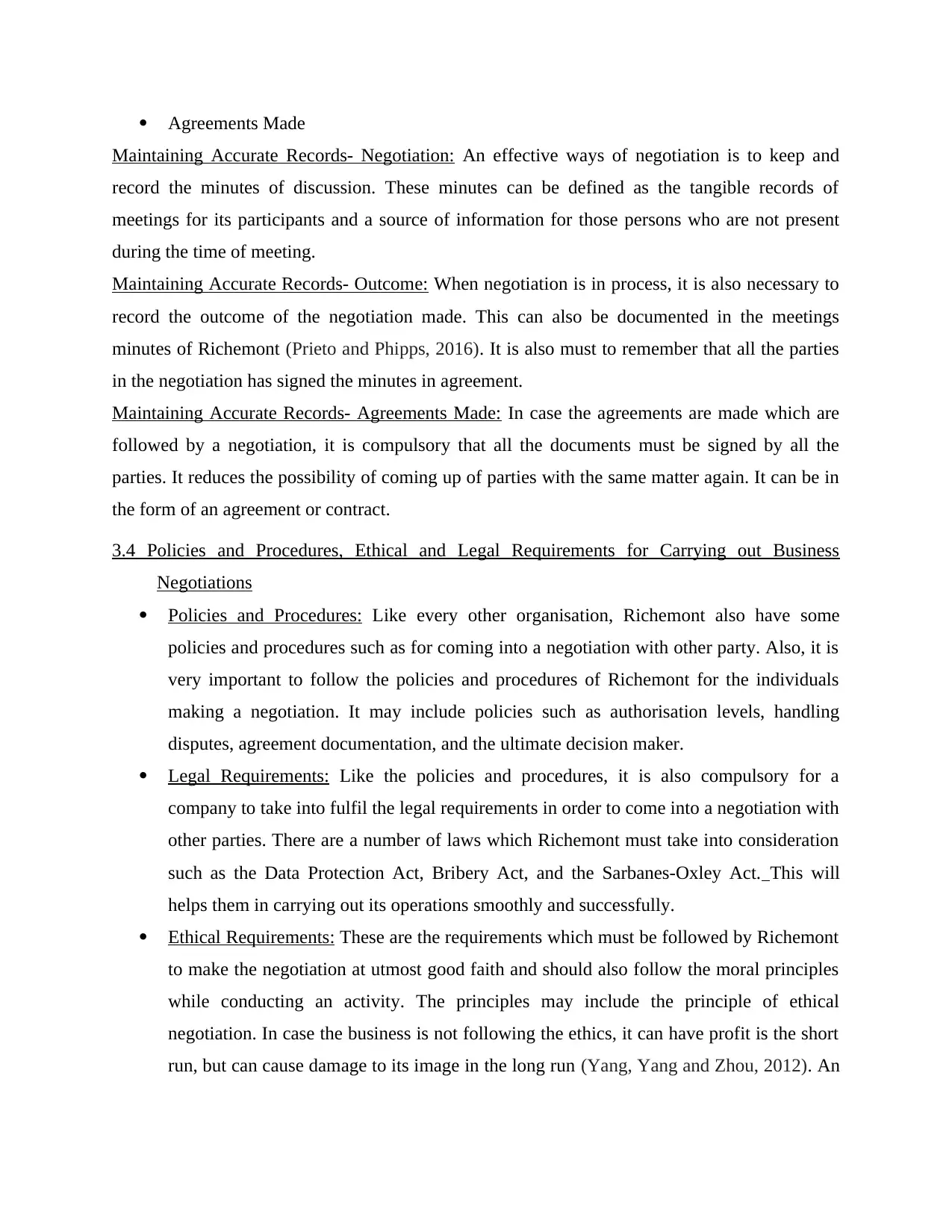
Agreements Made
Maintaining Accurate Records- Negotiation: An effective ways of negotiation is to keep and
record the minutes of discussion. These minutes can be defined as the tangible records of
meetings for its participants and a source of information for those persons who are not present
during the time of meeting.
Maintaining Accurate Records- Outcome: When negotiation is in process, it is also necessary to
record the outcome of the negotiation made. This can also be documented in the meetings
minutes of Richemont (Prieto and Phipps, 2016). It is also must to remember that all the parties
in the negotiation has signed the minutes in agreement.
Maintaining Accurate Records- Agreements Made: In case the agreements are made which are
followed by a negotiation, it is compulsory that all the documents must be signed by all the
parties. It reduces the possibility of coming up of parties with the same matter again. It can be in
the form of an agreement or contract.
3.4 Policies and Procedures, Ethical and Legal Requirements for Carrying out Business
Negotiations
Policies and Procedures: Like every other organisation, Richemont also have some
policies and procedures such as for coming into a negotiation with other party. Also, it is
very important to follow the policies and procedures of Richemont for the individuals
making a negotiation. It may include policies such as authorisation levels, handling
disputes, agreement documentation, and the ultimate decision maker.
Legal Requirements: Like the policies and procedures, it is also compulsory for a
company to take into fulfil the legal requirements in order to come into a negotiation with
other parties. There are a number of laws which Richemont must take into consideration
such as the Data Protection Act, Bribery Act, and the Sarbanes-Oxley Act. This will
helps them in carrying out its operations smoothly and successfully.
Ethical Requirements: These are the requirements which must be followed by Richemont
to make the negotiation at utmost good faith and should also follow the moral principles
while conducting an activity. The principles may include the principle of ethical
negotiation. In case the business is not following the ethics, it can have profit is the short
run, but can cause damage to its image in the long run (Yang, Yang and Zhou, 2012). An
Maintaining Accurate Records- Negotiation: An effective ways of negotiation is to keep and
record the minutes of discussion. These minutes can be defined as the tangible records of
meetings for its participants and a source of information for those persons who are not present
during the time of meeting.
Maintaining Accurate Records- Outcome: When negotiation is in process, it is also necessary to
record the outcome of the negotiation made. This can also be documented in the meetings
minutes of Richemont (Prieto and Phipps, 2016). It is also must to remember that all the parties
in the negotiation has signed the minutes in agreement.
Maintaining Accurate Records- Agreements Made: In case the agreements are made which are
followed by a negotiation, it is compulsory that all the documents must be signed by all the
parties. It reduces the possibility of coming up of parties with the same matter again. It can be in
the form of an agreement or contract.
3.4 Policies and Procedures, Ethical and Legal Requirements for Carrying out Business
Negotiations
Policies and Procedures: Like every other organisation, Richemont also have some
policies and procedures such as for coming into a negotiation with other party. Also, it is
very important to follow the policies and procedures of Richemont for the individuals
making a negotiation. It may include policies such as authorisation levels, handling
disputes, agreement documentation, and the ultimate decision maker.
Legal Requirements: Like the policies and procedures, it is also compulsory for a
company to take into fulfil the legal requirements in order to come into a negotiation with
other parties. There are a number of laws which Richemont must take into consideration
such as the Data Protection Act, Bribery Act, and the Sarbanes-Oxley Act. This will
helps them in carrying out its operations smoothly and successfully.
Ethical Requirements: These are the requirements which must be followed by Richemont
to make the negotiation at utmost good faith and should also follow the moral principles
while conducting an activity. The principles may include the principle of ethical
negotiation. In case the business is not following the ethics, it can have profit is the short
run, but can cause damage to its image in the long run (Yang, Yang and Zhou, 2012). An
Paraphrase This Document
Need a fresh take? Get an instant paraphrase of this document with our AI Paraphraser
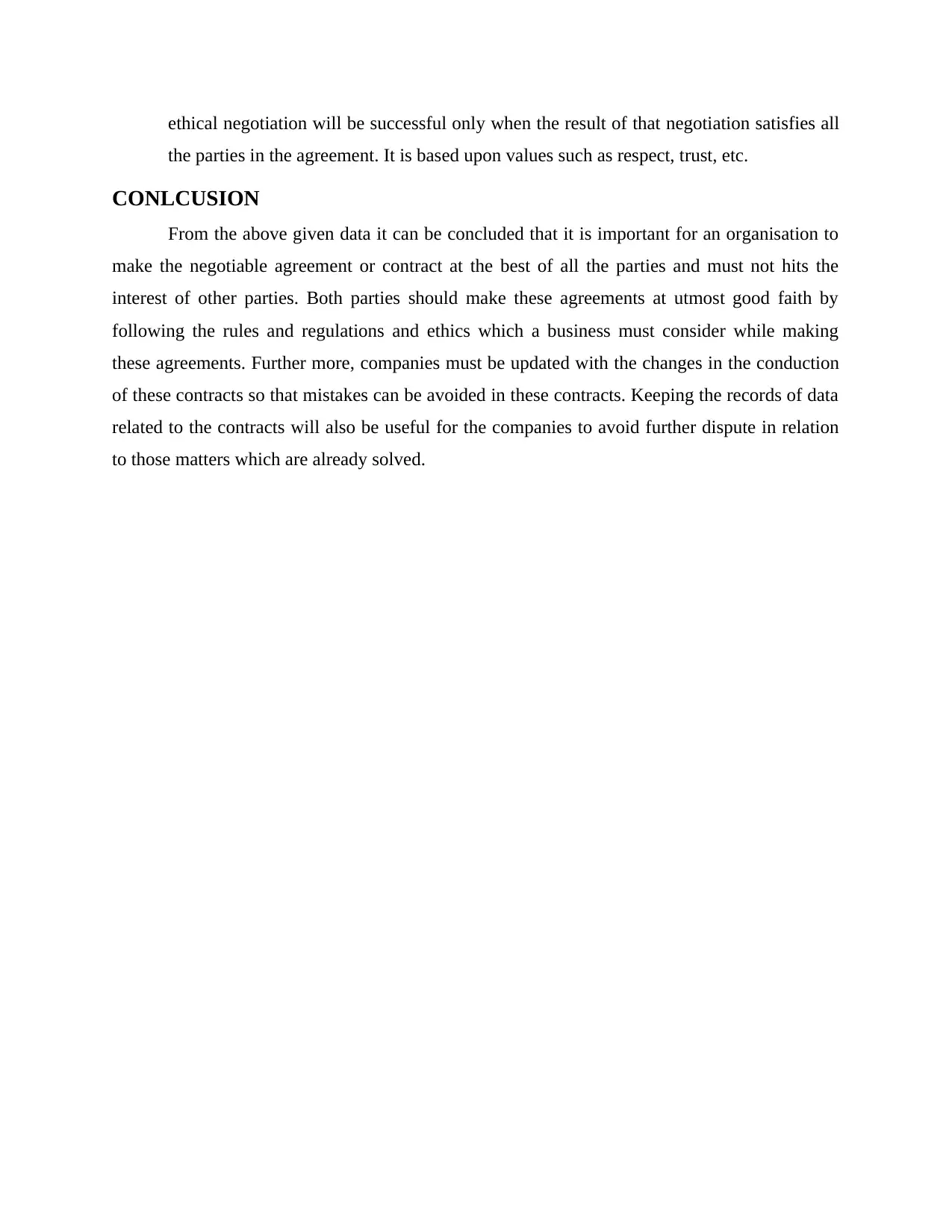
ethical negotiation will be successful only when the result of that negotiation satisfies all
the parties in the agreement. It is based upon values such as respect, trust, etc.
CONLCUSION
From the above given data it can be concluded that it is important for an organisation to
make the negotiable agreement or contract at the best of all the parties and must not hits the
interest of other parties. Both parties should make these agreements at utmost good faith by
following the rules and regulations and ethics which a business must consider while making
these agreements. Further more, companies must be updated with the changes in the conduction
of these contracts so that mistakes can be avoided in these contracts. Keeping the records of data
related to the contracts will also be useful for the companies to avoid further dispute in relation
to those matters which are already solved.
the parties in the agreement. It is based upon values such as respect, trust, etc.
CONLCUSION
From the above given data it can be concluded that it is important for an organisation to
make the negotiable agreement or contract at the best of all the parties and must not hits the
interest of other parties. Both parties should make these agreements at utmost good faith by
following the rules and regulations and ethics which a business must consider while making
these agreements. Further more, companies must be updated with the changes in the conduction
of these contracts so that mistakes can be avoided in these contracts. Keeping the records of data
related to the contracts will also be useful for the companies to avoid further dispute in relation
to those matters which are already solved.
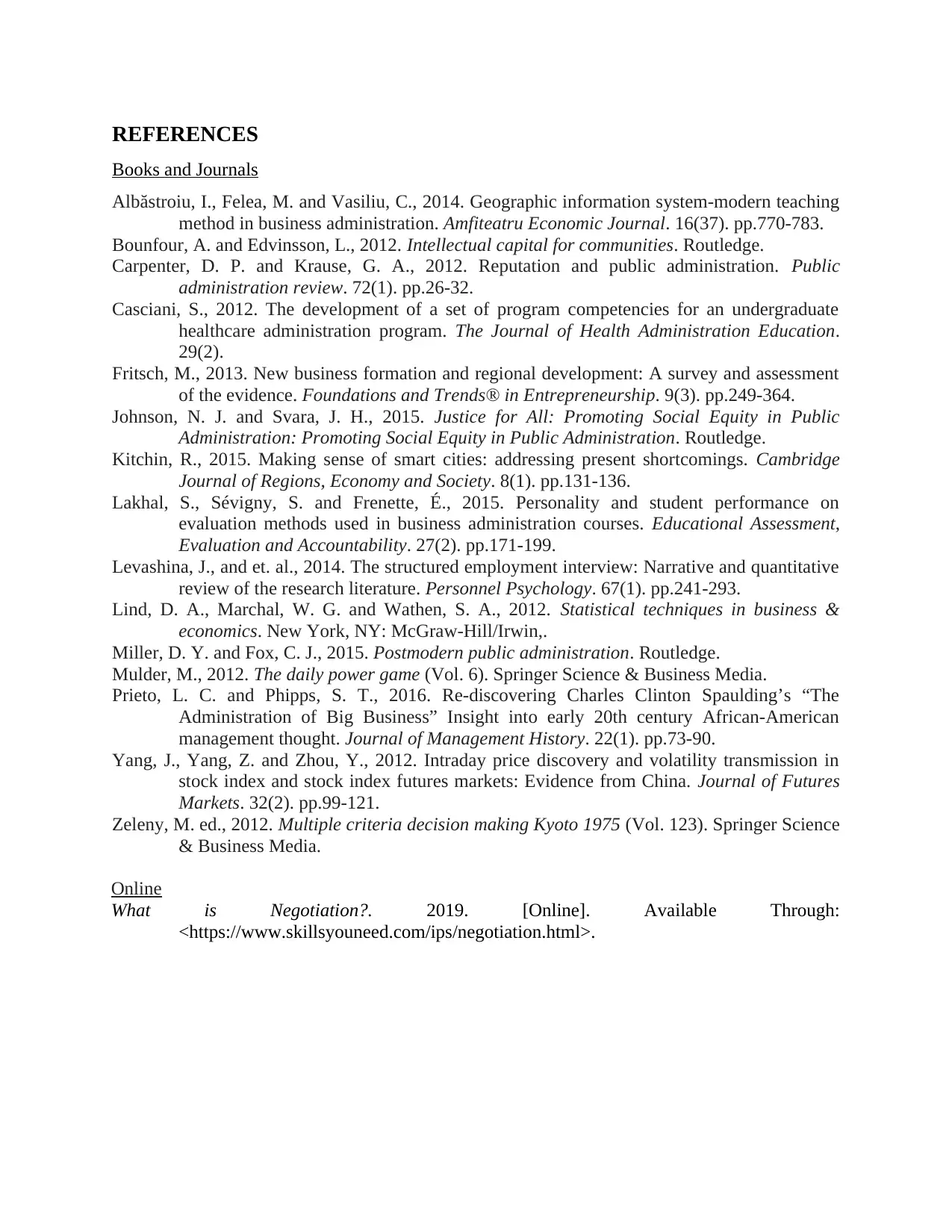
REFERENCES
Books and Journals
Albăstroiu, I., Felea, M. and Vasiliu, C., 2014. Geographic information system-modern teaching
method in business administration. Amfiteatru Economic Journal. 16(37). pp.770-783.
Bounfour, A. and Edvinsson, L., 2012. Intellectual capital for communities. Routledge.
Carpenter, D. P. and Krause, G. A., 2012. Reputation and public administration. Public
administration review. 72(1). pp.26-32.
Casciani, S., 2012. The development of a set of program competencies for an undergraduate
healthcare administration program. The Journal of Health Administration Education.
29(2).
Fritsch, M., 2013. New business formation and regional development: A survey and assessment
of the evidence. Foundations and Trends® in Entrepreneurship. 9(3). pp.249-364.
Johnson, N. J. and Svara, J. H., 2015. Justice for All: Promoting Social Equity in Public
Administration: Promoting Social Equity in Public Administration. Routledge.
Kitchin, R., 2015. Making sense of smart cities: addressing present shortcomings. Cambridge
Journal of Regions, Economy and Society. 8(1). pp.131-136.
Lakhal, S., Sévigny, S. and Frenette, É., 2015. Personality and student performance on
evaluation methods used in business administration courses. Educational Assessment,
Evaluation and Accountability. 27(2). pp.171-199.
Levashina, J., and et. al., 2014. The structured employment interview: Narrative and quantitative
review of the research literature. Personnel Psychology. 67(1). pp.241-293.
Lind, D. A., Marchal, W. G. and Wathen, S. A., 2012. Statistical techniques in business &
economics. New York, NY: McGraw-Hill/Irwin,.
Miller, D. Y. and Fox, C. J., 2015. Postmodern public administration. Routledge.
Mulder, M., 2012. The daily power game (Vol. 6). Springer Science & Business Media.
Prieto, L. C. and Phipps, S. T., 2016. Re-discovering Charles Clinton Spaulding’s “The
Administration of Big Business” Insight into early 20th century African-American
management thought. Journal of Management History. 22(1). pp.73-90.
Yang, J., Yang, Z. and Zhou, Y., 2012. Intraday price discovery and volatility transmission in
stock index and stock index futures markets: Evidence from China. Journal of Futures
Markets. 32(2). pp.99-121.
Zeleny, M. ed., 2012. Multiple criteria decision making Kyoto 1975 (Vol. 123). Springer Science
& Business Media.
Online
What is Negotiation?. 2019. [Online]. Available Through:
<https://www.skillsyouneed.com/ips/negotiation.html>.
Books and Journals
Albăstroiu, I., Felea, M. and Vasiliu, C., 2014. Geographic information system-modern teaching
method in business administration. Amfiteatru Economic Journal. 16(37). pp.770-783.
Bounfour, A. and Edvinsson, L., 2012. Intellectual capital for communities. Routledge.
Carpenter, D. P. and Krause, G. A., 2012. Reputation and public administration. Public
administration review. 72(1). pp.26-32.
Casciani, S., 2012. The development of a set of program competencies for an undergraduate
healthcare administration program. The Journal of Health Administration Education.
29(2).
Fritsch, M., 2013. New business formation and regional development: A survey and assessment
of the evidence. Foundations and Trends® in Entrepreneurship. 9(3). pp.249-364.
Johnson, N. J. and Svara, J. H., 2015. Justice for All: Promoting Social Equity in Public
Administration: Promoting Social Equity in Public Administration. Routledge.
Kitchin, R., 2015. Making sense of smart cities: addressing present shortcomings. Cambridge
Journal of Regions, Economy and Society. 8(1). pp.131-136.
Lakhal, S., Sévigny, S. and Frenette, É., 2015. Personality and student performance on
evaluation methods used in business administration courses. Educational Assessment,
Evaluation and Accountability. 27(2). pp.171-199.
Levashina, J., and et. al., 2014. The structured employment interview: Narrative and quantitative
review of the research literature. Personnel Psychology. 67(1). pp.241-293.
Lind, D. A., Marchal, W. G. and Wathen, S. A., 2012. Statistical techniques in business &
economics. New York, NY: McGraw-Hill/Irwin,.
Miller, D. Y. and Fox, C. J., 2015. Postmodern public administration. Routledge.
Mulder, M., 2012. The daily power game (Vol. 6). Springer Science & Business Media.
Prieto, L. C. and Phipps, S. T., 2016. Re-discovering Charles Clinton Spaulding’s “The
Administration of Big Business” Insight into early 20th century African-American
management thought. Journal of Management History. 22(1). pp.73-90.
Yang, J., Yang, Z. and Zhou, Y., 2012. Intraday price discovery and volatility transmission in
stock index and stock index futures markets: Evidence from China. Journal of Futures
Markets. 32(2). pp.99-121.
Zeleny, M. ed., 2012. Multiple criteria decision making Kyoto 1975 (Vol. 123). Springer Science
& Business Media.
Online
What is Negotiation?. 2019. [Online]. Available Through:
<https://www.skillsyouneed.com/ips/negotiation.html>.
⊘ This is a preview!⊘
Do you want full access?
Subscribe today to unlock all pages.

Trusted by 1+ million students worldwide
1 out of 12
Related Documents
Your All-in-One AI-Powered Toolkit for Academic Success.
+13062052269
info@desklib.com
Available 24*7 on WhatsApp / Email
![[object Object]](/_next/static/media/star-bottom.7253800d.svg)
Unlock your academic potential
Copyright © 2020–2025 A2Z Services. All Rights Reserved. Developed and managed by ZUCOL.





